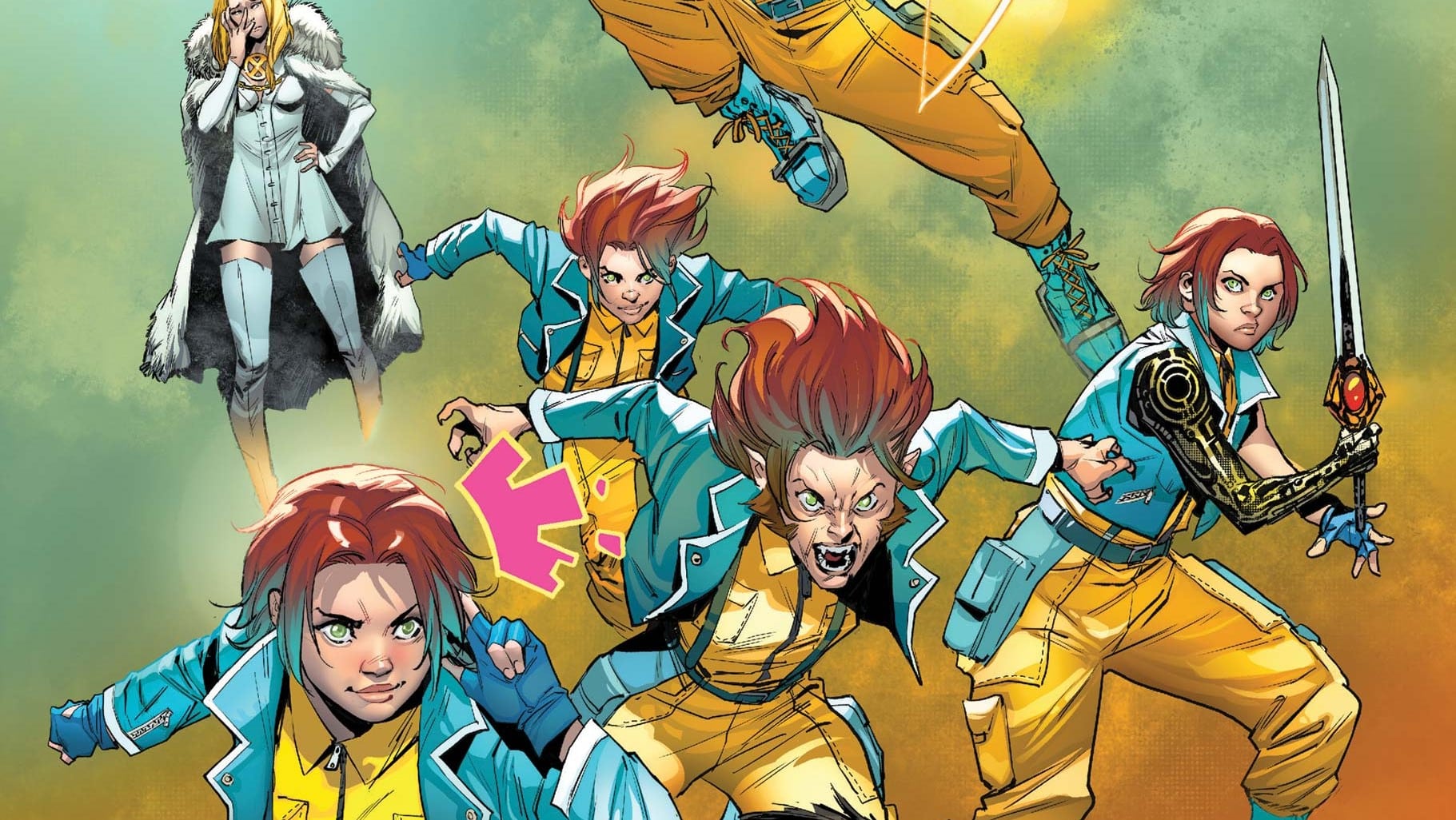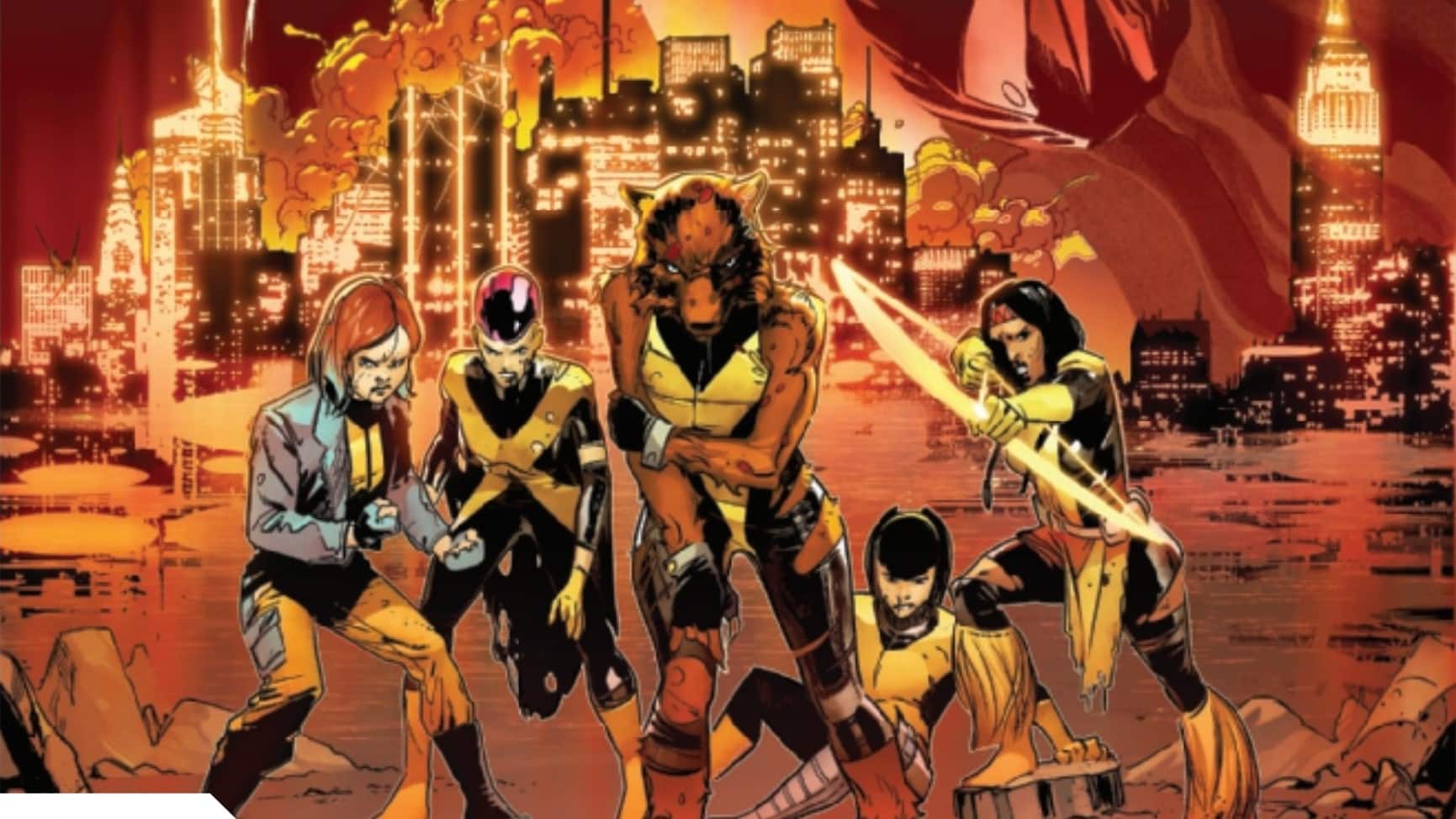The newest New Mutant is Escapade, whose mutant power lets her switch roles, or accessories, or skills, with anyone for a few hours. Now she’s switched her residence to Krakoa, but she’s got her doubts.. Oh, and the U-Men are back, hoping to harvest organs. It’s just like old times, except not, in New Mutants #31, written by Charlie Jane Anders, art by Alberto Albuquerque with Ro Stein, Ted Brandt, Carlos Lopez, and Tamra Bonvillain, letters by Travis Lanham.
Chris Claremont says somewhere that his secret to writing long-form comics is: never give the fans what they think they want. In that particular sense, Charlie Jane Anders has already failed at writing New Mutants: this first issue of her arc gives plenty of longtime X-fans what we want: it’s the tale of a charismatic, sympathetic, slightly under-powered trans girl character, in a first-person story that’s mostly big feelings, with the fight saved for the cliffhanger at the end.
It’s also a roaring success, and that roar you hear is the roar of self-recognition. Behind it you might hear the low buzz of critics and fanfiction writers descending, since Anders’s arc so far is all about fans and fandom and what we want, about how and whether X-comics build real-world communities, and it’s very self-consciously about whether Escapade– the self-doubting, wholly charming, redhead Shela Sexton, first seen in Andersl story for Marvel Voices: Pride (2022) with Ro Stein and Ted Brandt– belongs in these stories. In other words: it’s about where and whether you, X-fan, belong too.
At least it is if you are the reader this story anticipates: one who’s invested in the mutant metaphor, who’s been following the Lost Club, the school-age mutants at the center of Vita Ayala and Rod Reis’s run, since they got in trouble with the Shadow King. Shela (Escapade) has come to Krakoa to figure out how to avoid a scary prophecy: Destiny says that Shela will kill her best friend Morgan, a shy transmasc mutant who can turn things into chocolate, by switching her body with his at a risky moment. What moment? Why? And can the future change? It’s a classic question that comes with a classic offer: mutant solidarity, mutant community, mutants ready to solve mutant problems, if the mutant involved agrees to join the X-Men attend the Xavier School travel to the future move to Krakoa for a bit.
And it doesn’t quite work. Shela makes friends fast with the Lost Club, bonding over the fictional-show-within-a-work-of-fiction called Time Archer (Shela writes fanfic for it). She gets especially close to the powerfully psionic Cerebella, a.k.a. Martha Johansen. “Martha was just a brain in a globe until recently, and nobody wanted to help her out. They even gave her a mean nickname, No-Girl, like it was funny to them.”
Albuquerque’s sensitive, fluid pencils show the Lost Club in casual hangout mode, giving Cerebella the real-time, non-combat attention she’s always needed and rarely received, while her new body relaxes around her pals, legs dangling from a balcony, and if you don’t see a story about trans solidarity in these panels I’m taking my racquet back and going home. It’s not even an allegory, exactly, since Shela is literally trans, though Martha is allegorically so.
The Mutants in the Middle of the City

That’s not to say that Shela feels comfy: she can’t. “I keep finding out stuff that makes it hard to feel safe here,” she narrates. Show me five X-fans and I’ll show you seven opinions about the government and mores of Krakoa, and none of them wholly support the Council’s rule. On the other hand, on Krakoa she can “have fun with my powers for a change,” since those powers (like Prodigy’s, but more so) let her borrow other people’s abilities and expertise: she can tend bar, as long as she’s near Fred Dukes, or fly like Angel (borrowing Angel’s red 1980s costume). She can also wax melancholy about it: “Sometimes the worst thing about my power is that I get a taste of what it’s like to be someone else… and then I always snap back to my own problems.”
In other words, Shela Sexton’s power to become someone else temporarily, to have adventures with them, borrowing their body, and then return to her own life, looks like and stands for what we do when we read fiction, and especially when we read superhero comics. Ten page into her first New Mutants comic, Charlie Jane Anders has already given us beautiful figures for transness, for trans community, and for the power of fiction. And she’s not done.
Just as the best “escapist” fiction sometimes returns its heroes to the “real world” (those are scare quotes), the most vulnerable, youngest adult New Mutant, Rahne Sinclair, the one who likely feels closest to Escapade, offers to bring the Lost Club on a field trip back to Escapade’s native New York. Morgan takes a break from video games (of course he’s a gamer) to meet Shela in Washington Square Park. He brings his flying pet turtle, Hibbert, too. And Shela, like every extroverted trans girl with an introvert bestie, tries to make the awkward introductions: “always we’d have the new friend meet the old,” as an Irish superhero fan once said. “This is Leo, she loves games too. And this is Martha. She can sing in three different octaves.” Then they discuss, let’s face it, trans stuff. “I used to hate having a body,” Shela says, “but now I’m into it.” “Having a body rules,” Morgan agrees, “at least 70% of the time.” I agree.
Villains Say You Can’t Survive

Albuquerque and Bonvillain, also, rule: these conversations look easy, engaged, and visually various, and if you’re a New Mutants history type, you might say Rod Reis worked in the Bill Sienkiewicz tradition while Albuquerque and Bonvillain follow in the cleaner footsteps of Bret Blevins.”I still think Morgan has a point about Krakoa being kind of a cult,” Shela muses. (Like X-fandom.) “But I’m starting to understand why so many of us want to hide away on a beautiful island,” especially after anti-mutant crowds (even in New York) start throwing trash at Rahne and the students she brought.
Unfortunately the crowds include armored U-Men, members of John Sublime’s cult from the Morrison run, who kidnap and vivisect mutants to steal their powers. If you’re still reading this comic for the trans allegory, the U-Men are hostile doctors and other authority figure who want to restrict our movements, study us to death, and benefit from our existence while we get hurt. If you’re the kind of reader who wants to see superhero action in every superhero comic, congratulations: now you’ve got some, and it’s a genuinely suspenseful situation, with Rahne, Morgan, Escapade, Leo and Cerebella confined in a laser cage with power dampeners. Can they escape? Or will the U-Men force Cerebella, who’s been their tool before, back into her former brain-in-a-glass-globe situation, leveraging her powers to their evil ends?
As much fun– as (I’ll say it) relatable as Shela and Morgan remain, as much fun as the Peanuts-style cartoons about Shela and Morgan as children (remember those from Marvel Voices: Pride) get, the story reorients itself so that it’s primarily about Cerebella. She’s the one facing her former captors. She’s the one facing the familiar trans nightmare about going back to the way she was, when she didn’t have a body of her own, when malign or ignorant authority figures told her she was special and then told her what to do. She’s the one facing bad guys on the final, full-page panel, where her body language says she’s in fear for her life and Sublime, looking for all the world like an elected official from a racist political movement, stands tall, menacing and in control.
Cerebella also get this issue’s faux-handwritten, diary-style data page, which I won’t spoil by quoting. I can’t recommend it glowingly enough. We’ve seen her as the focus of stories before (e.g. the Generation Hope arc where Zero takes advantage of her). But we haven’t seen her as Charlie Jane Anders does: a good friend for a new mutant who’s had a raw deal.
All the Notes in the Sky
- Prose writers new to comics tend to use tons of words: either it’s clumsy, or it’s Claremontian. Here it’s Claremontian. The first-person narration helps.
- Why does Morgan’s turtle fly? Why is he named Hibbert? (After the novelist and essayist Talia Hibbert, who wrote this mutant-relevant essay?) Why do the U-Men who take the mutants captive let Morgan keep Hibbert?
- John Sublime is also the big bad in current Marauders: please tell us Charlie Jane Anders and Steve Orlando are on the same page?
Stephanie Burt is Professor of English at Harvard. Her podcast about superhero role playing games is Team-Up Moves, with Fiona Hopkins; her latest book of poems is We Are Mermaids. Her nose still hurts from that thing with the gate.






